
|   |

|   |
 e-mail: ukb7@rediffmail.com Magical, Mystical, Monumental Photos courtesy: Sutapa Talukdar April 6, 2017 Just as cultivators today turn their gaze skywards in India, anxiously seeking signs of rain, so did their ancestors - several hundreds of years ago. With every passing dry day, their anxiety, too, turned to desperation and finally to prayers. The sages then offered to invoke Parjanya, the rain god, in their hymn in the Rig Veda: Sing forth and laud for Parjanya, son of Heaven, who sends the gift of rain... May he provide our pasturage. Parjanya is the God who lays in cattle, in mares, in plants of earth, and in womankind, the germ of life… Offer and pour into his mouth oblation rich in savoury juice. May he forever give us food…Parjanya Devata (The Rain God), a dance production blending Odissi and Western classical dance form, presented recently in Kolkata by Victoria Memorial Hall in association with South Gurukul Society, could not have been a more grandiloquent affair, in terms of all three elements needed for performative arts: space, time and characters. Its locale was the elevated backdrop of Western Quadrangle of a one-century-old colonial edifice, built in Indo-Saracenic style with picturesque Venetian, Egyptian, Deccani and Islamic architectural influences. The colonial behemoth offered a huge front façade of 350 feet, rising to an awesome height of 200 feet, all in gleaming white Makrana marble, surrounded by the most spacious and luscious English gardens. 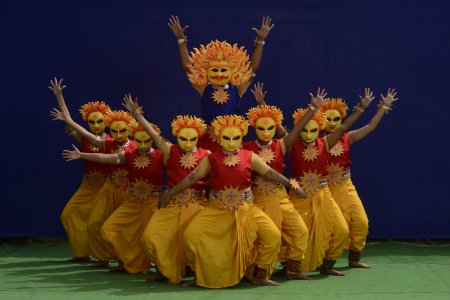 Surya Choreographed by the noted Odissi dancer Sutapa Talukdar, there sauntered in, at various points, as many as seventy-five dancers – in variegated formations celebrating the Rain God - to create a time-continuum since the earliest ages to the present day. The performance harked back to the mythical era: with the sun rising from the multi-hued east. Drawn by eight (not seven?) masked charioteers in multiple directions and the Sun reining them in, in his glorious mask, the spectacle created a mesmerising effect. At the other end of the proscenium stage was the chanting sage, flanked by disciples. In various zones were clusters of dancers - executing choreographic patterns of various geometric designs. Indeed, at any given point, there were as many as nine choreographic groups occupying the vast arena. The Rig Vedic invocation rent the air: Sing with these songs your welcome paeans to the Mighty, with the bull roaring loud, swift to send his lays in the plants the seed for germination… With adoration and praise, call Parjanya…Thunder and roar: deposit the germ of life … Fly around us with your water-laden chariot… Draw yourself downward with your opened water-skin and let the hollows and the heights be levelled… Burst forth the winds, let down the lightning-flashes: let the plants shoot up, the realm of light streaming…Let food spring abundant for all living creatures, when Parjanya quickens earth with moisture… At your bidding earth bows low before you… at your command hoofed cattle flee in terror… At your behest the plants assume many colours… Even you, Parjanya, yield us great protection… You have poured down the rain-flood now as well as withheld it … You have made deserts a place for travel… You have made herbs grow for our enjoyment… Yes, you have won yourself praise from all living creatures... 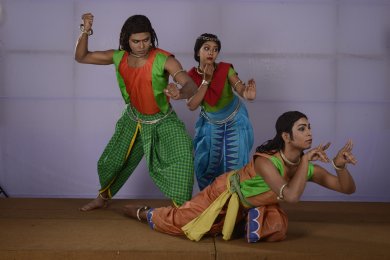 Kalketu- Phullara 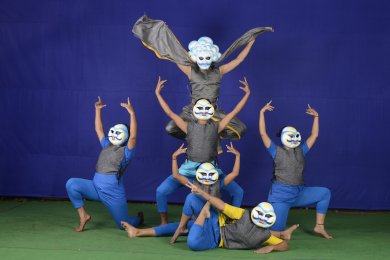 Megh 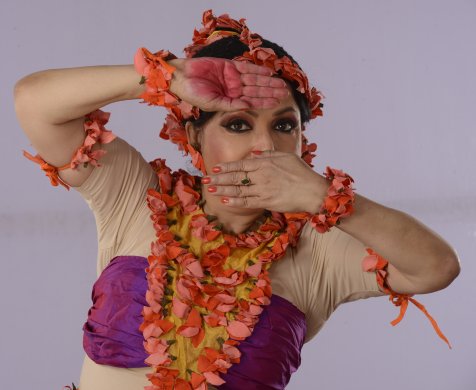 Dharitri 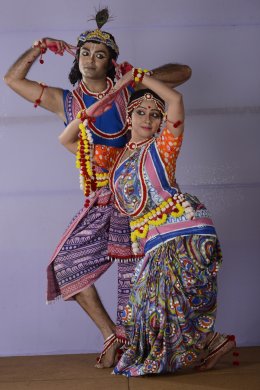 Radha- Krishna Then floated in the blue attired clouds. If the Sun-God’s contingent had elaborate Seraikella masks, the cloud donned stark white Seraikella masks and danced to sinuous Chhau movements. Of particular interest were manifold ‘trees’ and ‘plants’ with male and female dancers inter-twining each other to create an arboreal grandeur, especially dedicated to the Rain God. Naturally, presiding over them was Dharitri, donned by Sutapa herself. The narrative inevitably shifted to Eastern India. Especially poignant were the excerpts from the twelfth-century Jayadeva’s Gita Govinda, with the eternal love play of Radha-Krishna, the staple especially of the Odissi genre. A charming dancer-duo executed their pas de deux in the imagined Vrindavan parlour amidst spluttering rains, thundering storms and croaking frogs. This gave way to the sixteenth-century Kabikankan Mukundaram, who gave definite shape to the tales of Chandi Mangal. Belonging to Noakhali and Chittagong region (now in Bangladesh), Mukundaram excelled in portraying the joys and sorrows of human life particularly in his ballad of Phullara-Kalketu. The character of Phullara came through very well, as full of life even while she was seeking alms in a miserable monsoon, tortured by the goons, with a sense of universality and humanity. Bengal and Mithila of the seventeenth and eighteenth century abounded in Vaishnava Padavali poets like Vidyapati and Chandidas, whose lyrics accompanied some charming dance sequences of Nayika. There was an interregnum to the present day for the worthy bearer of Padavali heritage, Rabindranath Tagore, whose evocative song fleeted through: Come to the Neepa woods under its shaded arbour / Let us get drenched by the new, incessant showers … The finale was the modern segment of the evening where dancing and prancing boys and girls leapt and pirouetted with umbrellas: opened, rotated and shut. Surely this was no “Western classical dance” as was announced. In a very well-conceived program (the choreographer confessed to have been working on the theme “over a decade since 2006”), there were a few avoidable chinks in the armour. First, lighting was indifferent, involving a back-row of skylights directly impinging on the audience’s eye and full frontal lights were not much help to illumine the dancers’ torsos. Light zones on the stage were not focussed up on, in multiple action scenes. Second, the off-stage dancers seemed to move casually to and fro in the background, negating the front stage action scene. Lastly, the title of the evening referred to a Vedic deity, at a time and clime when the Puranic icons have not come into existence. To have an image of Lord Jagannath - deserving of our full reverence - installed on front stage seemed incongruous when Parjanya had no physical attribute. These oversights, however, did not in any way take away the choreographer’s most valiant efforts, deserving our full encomium.  Dr. Utpal K Banerjee is a scholar-commentator on performing arts over last four decades. He has authored 23 books on Indian art and culture, and 10 on Tagore studies. He served IGNCA as National Project Director, was a Tagore Research Scholar and is recipient of Padma Shri. Comments Loved the mesmerizing performance. Excellent dancers and eye feasting performance. Truly an inspiration. - Anusree Guha (April 12, 2017) Post your comments Please provide your name and email id when you use the Anonymous profile in the blog to post a comment. All appropriate comments posted with name & email id in the blog will also be featured in the site. |